Inside the Mind of a Snowmobile Test Rider

We can agree to disagree and that's a good thing
“Piece of crap,” the young editor test rider proclaimed. He had just brought the sled up to a stop, climbed off and stepped away from the brand new 1980 snowmobile that hadn’t measured up. Would “piece of crap” be the official verdict for that brand new model? In that test rider’s mind it could have been.
Years later another test rider, invited along on a publication’s new model evaluation and a bright young fellow who professed his unbiased ability to judge new models based on a recently acquired engineering degree, never met a poor Polaris. Turns out that he owned one. He’d grown up in a family that was pure Polaris 24/7. To his purely analytical thinking, no other new models he rode could measure up to his favorite brand. On a scoring scale of 1-to-10, others could get a 9, but none but his favorite brand ever got 10s.
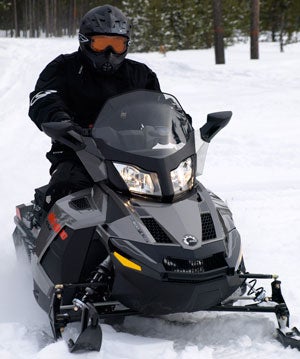 There are many similarities between Ski-Doo’s GSX and TNT, but the intended rider is quite different from one to the other.
There are many similarities between Ski-Doo’s GSX and TNT, but the intended rider is quite different from one to the other.It’s quite possible that our views as reviewers are colored by some bias. In the case of the “piece of crap” comment, let’s look at the reviewer. An avid and experienced snowmobiler with sleds of his own, this reviewer was the managing editor of what was at he time one of the world’s largest circulation snowmobile publications. He really despised the ride of that “crappy” sled. But, to understand his viewpoint you needed to look more closely at the test rider and to realize that this was a stout person with a very short inseam. The “crappy” sled that he rode had a fuel tank that stretched back toward the rear of the seat, and it lacked adequate protective covering on some models. A popular selling model, this sled did, indeed, cause actual pain to any short-statured rider. A six-footer with a longer inseam would never notice this complaint. The point is that the reviewer never considered that maybe the sled didn’t fit him. In fact for a taller rider the sled was quite good. It had very good power. It’s handling ranked better than average in that age of leaf sprung skis. But the gas tank was made of hard plastic and it did stretch back causing discomfort for short-legged riders. That was all that mattered to him and he wouldn’t consider it as being anything other than a “piece of crap.” He wouldn’t look at how the sled filled the needs of other riders and how the model continued to be a popular seller. In fairness, the manufacturer would add a cushioned cover for the tank in later model years. So, the test rider did have a point.
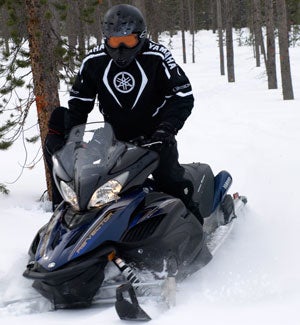 Yamaha’s Apex is a quality power sled, but will it satisfy a two-stroke big bump rider? Today we have quality choices to suit our biases.
Yamaha’s Apex is a quality power sled, but will it satisfy a two-stroke big bump rider? Today we have quality choices to suit our biases.As for the guest test rider who loved a specific brand and down graded all other models simply because it wasn’t the proper brand, his bias affected the overall test scoring to such a point that his scores were not counted.
Here at Snowmobile.com we have test riders of varying skill and knowledge levels. For the annual mountain sled evaluations we’ve been blessed with a cadre of experienced powder riders who get it. They have owned and ridden a variety of brands that satisfy their specific snowmobiling needs. But they can understand that just because one sled may not excel at their personal and very specific preferences, that the sled can be perfect for another rider or other snowmobiling conditions.
We fully understand and accept that when it comes to test riding snowmobiles and reviewing them, there comes a point where readers will either agree or totally disagree with certain views. As a snowmobile reviewer for many, many years, I’ve been accused of being biased for and against virtually every brand on the snow. That view has been held by readers as well as various snowmobile brand representatives, some of whom moved from one brand to another. Frankly, I embrace that love/hate view to a review.
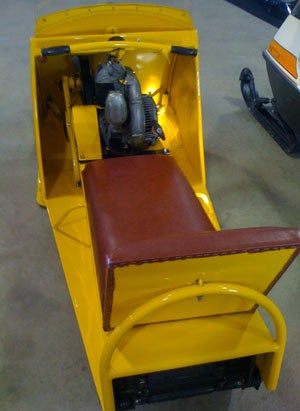 Riding with one knee on that thin old Ski-Doo seat was never good long term and could result in “Ski-Doo knee.”
Riding with one knee on that thin old Ski-Doo seat was never good long term and could result in “Ski-Doo knee.”And, yes, there are some sleds we prefer to others — at a very personal level. While we can share some of that in a review, we always have to look for how a sled may best fill a need in its intended niche.
For my own personal sled, I enjoy a 2006 Ski-Doo 550cc fan-cooled REV MXZ Bumble Bee. It’s light and very nimble on the tight trails where I ride. I grew up in New England riding Ski-Doo Olympiques and have Ski-Doo knees to prove it. FYI, Ski-Doo knees come from riding with one knee on the seat and the other leg bracing you with foot locked into the runningboard’s passenger stirrup. Riders of 1960 through 1970s vintage sleds understand the technique.
Would I recommend the sled as being the best answer for other sledders? Not likely. And that is not to say that I don’t enjoy a high-powered trail ripper. It just means that when I’m on my own and looking to recapture some old memories, that old REV does the trick. For serious long haul tripping on well-groomed trails with lots of straights, give me a Yamaha Apex, an 800 Adventure or a turbo Cat. Big bump riding wants me wishing for a Switchback or a 600 MXZ with rMotion. For simple snow scooting around when the miles don’t matter as much as the ride, that new Polaris 600 Indy SP, a Cat F1100 or Ski-Doo MXZ with 600 ACE can be fun rides.
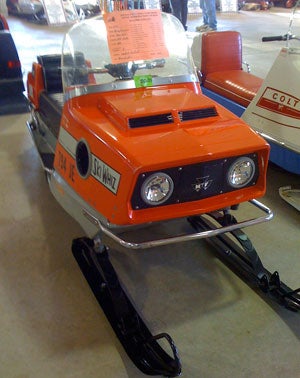 Some sleds from the “good old days” are simply old and those past days weren’t always that good.
Some sleds from the “good old days” are simply old and those past days weren’t always that good.It’s our job as reviewers to look beyond what we prefer. Looking at various chat areas, we see many commentators with similar open views as the official test riders. If there were only one answer to every sledder’s needs, then we’d see just four models — one from each maker. But we all have opinions and there are many models from which to choose. Heck, virtually every time a sled manufacturer asks its customers what they’d like to see in a new sled, they get inundated with more things to add or create for the future.
Is the buyer who wants a sled that can carry two people over groomed trails at normal trail speeds well served by a report that faults the sled because it has soft shocks and can’t bang hard through the big bumps at top speeds? What about the diehard two-stroke fan that can’t see anything positive about a four-stroke powered sled? And, let’s get real, when it comes to snowmobile products, when was the last time you rode a true piece of crap?
Well, that’s for those of you who don’t ride vintage sleds. Having tested and reviewed sleds from the good old days, we can tell you for a fact that there were some true pieces of crap back then. Many chose to romanticize those old sleds. Not this test rider. Even our most favorite sled from back in the day couldn’t begin to approach the worst of today’s sleds for quality, durability and overall reliability.
When we wrote reviews of those sleds there were some real shortcomings. Brakes ranged from effective to worthless. Some sleds had scissor-type brakes and some came with a Kelsey-Hayes hydraulic disc brake system that provided insight into today’s designs. Many systems were carryovers from the earliest days of automobiles or, at best, contemporary versions of the band brakes seen on lawn tractors of the times. What could slow down a lawn mower from 5 miles per hour was marginally adequate for a snowmobile that could reach 45 mph. The brake cables would stretch. They’d freeze. The bands would glaze.
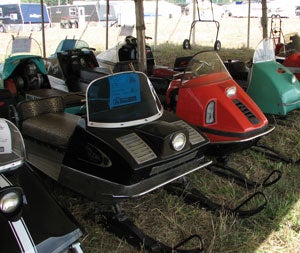 We romanticize the sleds of yesterday, but would we be happy if those were all we had today?
We romanticize the sleds of yesterday, but would we be happy if those were all we had today?Some sleds had headlights that couldn’t reach very far beyond the ski’s tips. And drivelines, while similar in concept to what we see today, were far from being very good at transitioning power.
When we test rode those sleds, there were true faults. Breakthrough technologies like hand warmers deserved coverage. The move to flat slide carburetors meant something as they did affect performance. There was the battle over suspension travel as sled manufacturers established cushy rides that absorbed big bumps. We have seen the move to ride-forward chassis designs and engines that utilize sophisticated fuel injection systems.
When the snowmobile industry shrunk to just four sled makers, we saw only quality builders being left. Today all snowmobiles are very, very good. That is not to say that we don’t have our special favorites. So do you. But we can test ride a sled, appreciate its character and have a feel as to whether or not it will satisfy its intended buyer niche. Whether we like the sled or not, all modern snowmobiles have been built to fill a need. The large niches are heavily contested and we report on them as suiting specific riding types.
One thing we know beyond any doubt is that there are no pieces of crap.
Related Reading First Impressions of the 2013 Snowmobiles Snowmobile Sales Leaders Through the Years How Ski-Doo Changed Snowmobiling in 2003 Polaris Returns to its Snowmobiling Roots








 Your Privacy Choices
Your Privacy Choices